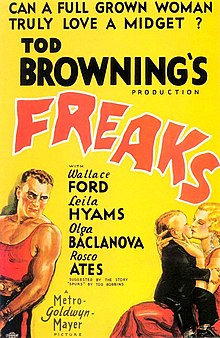| Freaks | |
|---|---|
 1932 theatrical release poster | |
| Directed by | Tod Browning |
| Screenplay by | |
| Based on | "Spurs" 1923 story by Tod Robbins |
| Produced by |
|
| Starring | |
| Cinematography | Merritt B. Gerstad |
| Edited by | Basil Wrangell |
Production company | |
| Distributed by | Loew's Inc. |
Release date |
|
Running time | 64 minutes[2] |
| Country | United States |
| Languages | English German French |
| Budget | ~ $310,000[a] |
| Box office | $341,000[3] |
Freaks (also re-released as The Monster Story,[6]Forbidden Love, and Nature's Mistakes[7]) is a 1932 American pre-Code drama horror film produced and directed by Tod Browning, starring Wallace Ford, Leila Hyams, Olga Baclanova, and Roscoe Ates.
Freaks, originally intended as a vehicle for Lon Chaney,[7] is set amongst the backdrop of a travelling French circus and follows a conniving trapeze artist who joins a group of carnival sideshow performers with a plan to seduce and murder a midget in the troupe to gain his inheritance. However, her plot proves to have dangerous consequences. The film is based on elements from the short story "Spurs" by Tod Robbins, first published in Munsey's Magazine in February 1923, with the rights being purchased by Metro-Goldwyn-Mayer (MGM). Cedric Gibbons, a childhood friend of Robbins and MGM art department chief, was responsible for the purchase.[6]
Filmed in Los Angeles in the fall of 1931, some employees at MGM were discomforted by the presence of the actors portraying the "freaks" on set, and, other than the so-called more normal looking "freaks", the Siamese twins and the Earles, the performers were not allowed to be on the studio lot, relegated instead to a specially-built tent.[7] The film had test screenings in January 1932, with many members of the audience reacting negatively, finding the film too grotesque. In response to this, MGM executive Irving Thalberg, without consent of director Browning, edited the original 90-minute feature, which was significantly cut, with additional alternate footage incorporated to help increase the running time. The final abridged cut of the film, released in February 1932, was 64 minutes; the original version no longer exists.
Freaks made its world premiere at the Fox Theatre in San Diego, shown in full, without the subsequent cuts from January 28 and had a successful run. The theatre advertised the fact that it was the only place where the movie could be seen in the "original uncensored version".[7]
Despite the cuts made to the film, Freaks still garnered notice for the portrayal of its eponymous characters by people who worked as sideshow performers and had real disabilities. These cast members included midget siblings Harry and Daisy Earles; Johnny Eck, who had sacral agenesis; the conjoined twin sisters Daisy and Violet Hilton; and Schlitzie, a man with microcephaly. Because of its controversial content, the film was banned in the United Kingdom for over 30 years, and was labelled as "brutal and grotesque" in Canada.[8]
Though it received critical backlash and was a box-office failure upon initial release, Freaks was subject to public and critical reappraisal in the 1960s, as a long forgotten Hollywood classic, particularly in Europe, and was screened at the 1962 Venice Film Festival. In retrospect, numerous film critics have suggested that the film presents a starkly sympathetic portrait of its sideshow characters rather than an exploitative one, with Andrew Sarris declaring Freaks one of the "most compassionate" films ever made.[9] Nonetheless, critics have continued to take note of the film's horror elements; in 2009, Joe Morgenstern proclaimed that Freaks contains some of the most terrifying scenes in film history. Film scholars have interpreted the film as a metaphor for class conflict, reflecting the Great Depression, and it has been studied for its portrayal of people with disabilities, with theorists arguing that it presents an anti-eugenics message. The film has been highly influential, has become a cult classic, and, in 1994, was selected for preservation by the United States National Film Registry, which seeks to preserve films that are "culturally, historically, or aesthetically significant".[10][11]
- ^ Cite error: The named reference
lat1932was invoked but never defined (see the help page). - ^ "FREAKS (12)". British Board of Film Classification. August 13, 2001. Retrieved July 19, 2013.
- ^ a b Mank 2005, p. 127.
- ^ Eyman 2005, p. 152.
- ^ "Metro's 'Freaks' Going Out As Exploitation Special In First Outside Sale". Variety. October 1947. p. 5 – via Internet Archive.
- ^ a b Elias Savada (2004). "The Making of "Freaks": The events leading up to the creation of Tod Browning's classic film". Archived from the original on December 21, 2022. Retrieved July 10, 2023.
- ^ a b c d "11 Astonishing Facts About Tod Browning's Freaks". July 6, 2018.
- ^ "Obituaries: Tiny Doll". The Telegraph. September 15, 2004. Archived from the original on July 24, 2016.
- ^ Skal 1995, p. 224.
- ^ "25 Films Added to National Registry". The New York Times. November 15, 1994. ISSN 0362-4331. Retrieved October 2, 2020.
- ^ "Complete National Film Registry Listing". Library of Congress. Retrieved October 2, 2020.
Cite error: There are <ref group=lower-alpha> tags or {{efn}} templates on this page, but the references will not show without a {{reflist|group=lower-alpha}} template or {{notelist}} template (see the help page).